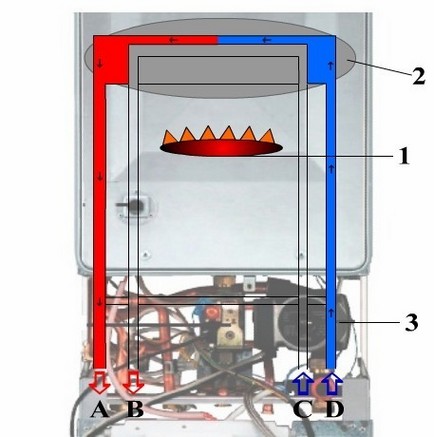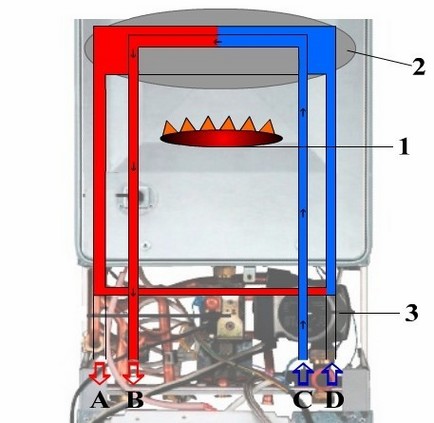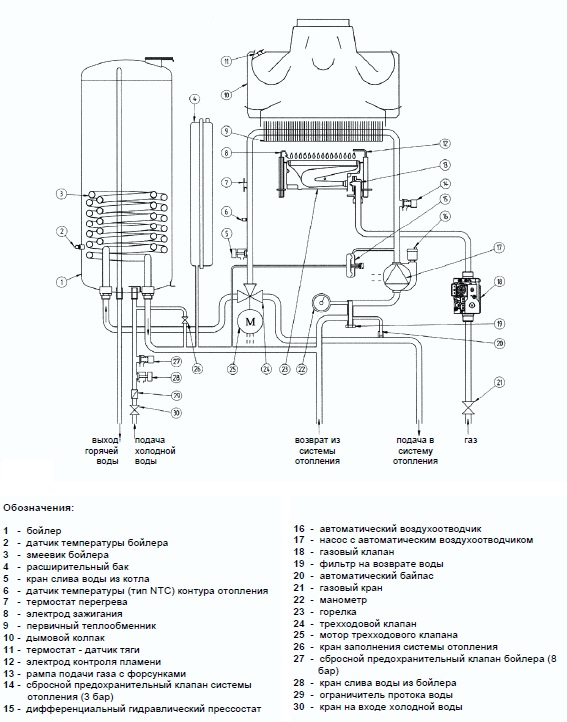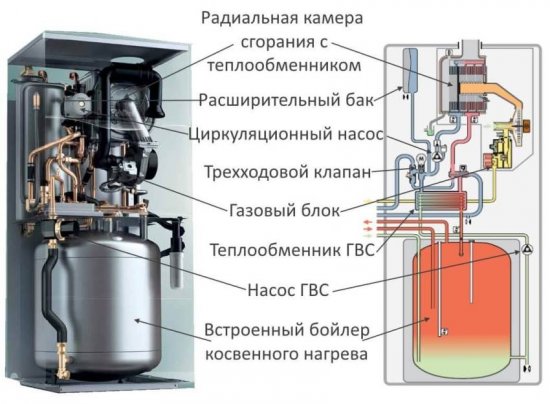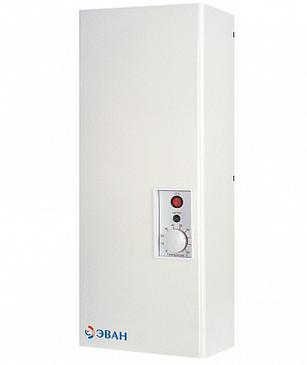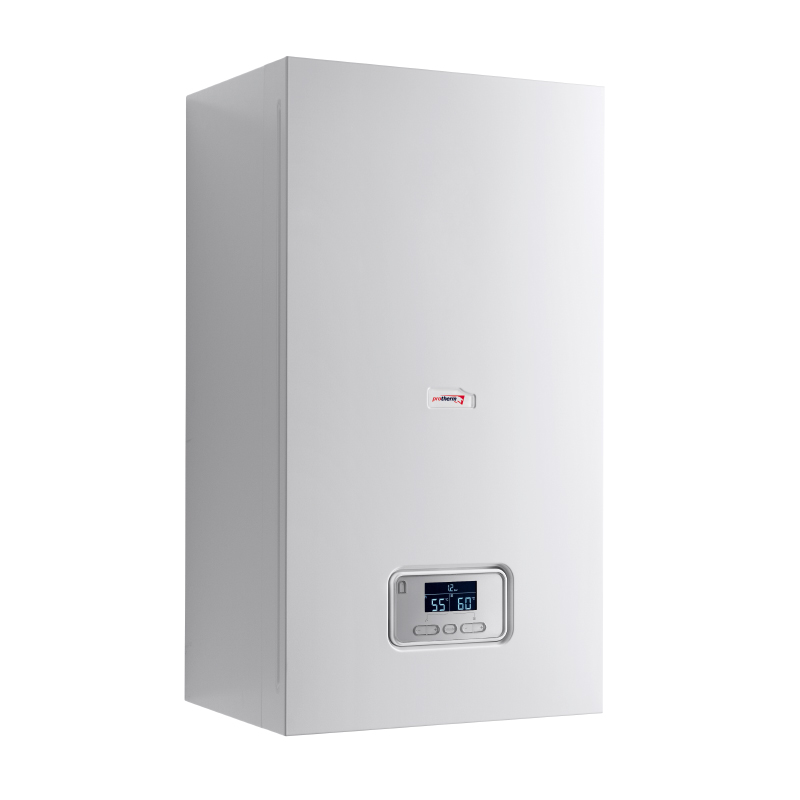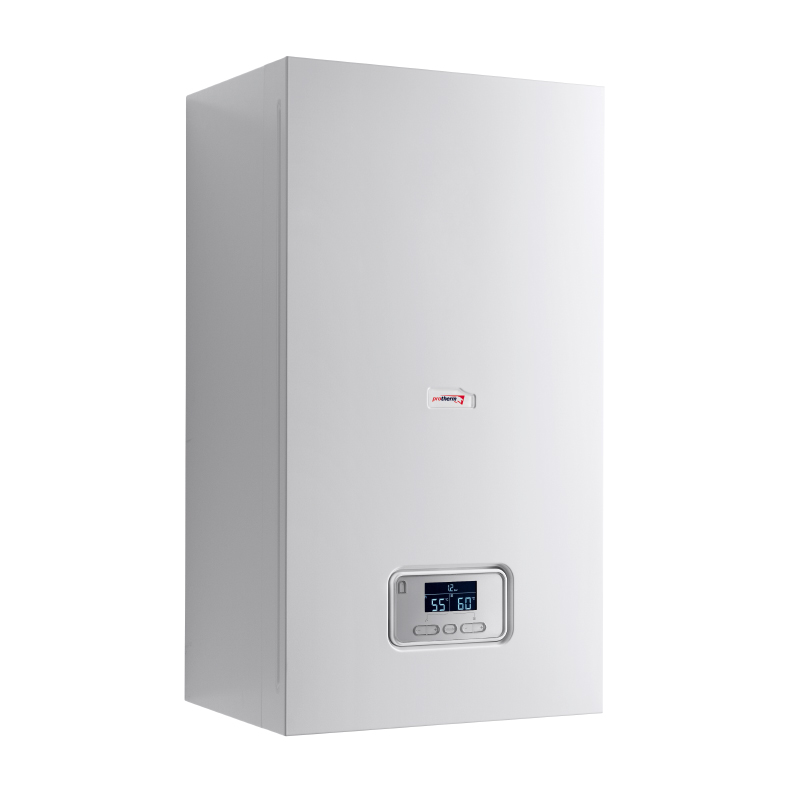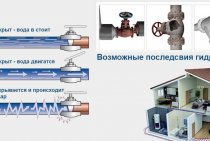Subtleties of using boilers
It should be clarified that electric current is necessary for the full operation of the boiler. The exception is units operating on solid fuels: they are able to work autonomously. So if there are power outages in your room, then you should take a closer look at solid fuel appliances.
Electricity is needed to operate the pumps and the entire boiler system. If the locality in which you live is periodically disconnected from the mains, and you do not want to use solid fuel boilers, then a good solution would be to purchase an electric generator.
Manufacturers of heating equipment are concerned about the safety of customers. Any model of a modern boiler is equipped with special sensors and other protective systems.
We list the most common of them:
- Traction control sensor.
- A sensor that detects the presence or absence of a flame.
- A mechanism that stops the operation of the boiler in the event of a decrease in pressure in the gas pipeline below a certain mark.
- A system that protects the boiler from overheating.
- A mechanism that shuts down equipment in the event of a power outage.
- A sensor that turns off the heater in the absence of the required amount of fuel in it.
All protective systems listed above must be installed on heating equipment. They will save the owner from death, his home from fire, and the boiler from breakage.
If we talk about the location of the boiler, then it all depends on its model. There are heaters with a power of no more than 100 kW - such units can be installed directly in the kitchen.
More powerful boilers must be installed in a specially equipped room. The layout of the boiler room needs to be thought out and discussed with professionals so that they can help design fire safety devices, as well as competently draw up a plan for the ventilation system.
Summing up, I would like to say that gas boilers are most common in the post-Soviet space. This can be explained by the availability of this type of fuel, the inexpensive cost of gas boilers, as well as the high efficiency and reliability of this heating equipment. However, in settlements where central gas heating is turned off, the choice of this device is not a profitable and optimal option.
We told what heating boilers are for a private house, and also listed their advantages and disadvantages. It should be remembered that reducing the cost of maintaining equipment and economical fuel consumption is an important component of choosing a unit. In our article, you learned how to choose a boiler for heating a private house. Using this information, you will be able to customize the model of heating equipment that suits your needs.
The principle of operation of boilers on pellets
Pellet is a biofuel that can be compressed wood, peat pellets, as well as agricultural waste.
Pellets are often in the form of briquettes or cylinders. They measure from 4 to 10 millimeters in diameter, and also from 2 to 5 centimeters in length. In the process of their production, shavings, sawdust, and sunflower husks are often used.
The indisputable advantages of pallets include autonomy of work. Many solid fuel boilers have a small compartment for loading pellets, and a special mechanism puts them into the boiler from time to time. Under normal conditions, this fuel is enough for two to three days.
It happens that the owners of houses resort to tricks and organize a small bunker of three to four cubic meters in the room adjacent to the heating system, from which a special mechanism removes pellets and delivers them to the very mouth of the boiler. This well helps to increase the battery life of the heating system.
With proper system setup, battery life can reach up to one month. If we talk about efficiency, then pellet boilers have a higher efficiency than conventional ones. Also, heating devices benefit even from units operating on organic and inorganic compounds.
List of disadvantages of pellet boilers:
- High cost of fuel. Due to the fact that this type of boiler is very complex, it is very sensitive to the quality of the fuel thrown into it. If you save on consumables, the boiler can quickly become unusable. For this unit, it is necessary to use only types of pellet granules of class A and B, which were produced by foreign manufacturers.
- Boiler cost. This type of heating equipment is very expensive, on the market its price originates from two thousand US dollars. It is for this reason that pellet boilers have not gained immense popularity in the post-Soviet space.
The main criteria for choosing boilers
Our and foreign manufacturers offer a huge selection of heating equipment. It will be difficult for a person who does not understand the devices of heating equipment at all to understand which boiler is better for a private house. It is difficult, without knowledge, to navigate and choose a worthy option from the whole variety of models. Often a person wants to get a quality product for little money.
Let's talk about the categories of heating appliances. There are different types of heating boilers for a private house. They are distinguished by the type of fuel:
- Gas (condensing and conventional).
- Electric (powered by electricity).
- Solid fuel (work on coal, wood, peat, pellets).
- Liquid fuel (work on diesel fuel).
- Universal (work on electricity or gas).
In order to select a suitable category of boilers, it is advisable to analyze and select the fuel that will be most beneficial to use in your locality. It is necessary to determine what level of comfort, safety and reliability you want to receive for the funds invested in the boiler.
This is a key point in choosing a heater. You need to take this process seriously so that later you do not regret the thoughtlessly spent money. We will consider the main steps to be taken when choosing a boiler:
- Make a table with the pros and cons of all categories of boilers.
- Determine how much heating boiler power is enough for your home.
- Determine the required number of circuits.
- Decide where in your home it is best to install heating equipment.
The place where the boiler is located plays a key role in choosing a heating unit. After all, it is not advisable for a small room to buy a huge cast-iron apparatus.
Schemes for connecting a water heater to a gas boiler.
Now let's move on to considering the connection diagram of the water heater to the DHW circuit of the boiler. So let's look at the picture below:
It can be seen from the figure that the storage water heater is connected separately to the boiler and to consumers. Separation is done by two 3-way valves with servomotors. Switching the servos and turning on the circulation pump is carried out by a certain device called the “power management circuit”. This device is connected to the water heater thermostat. There are no standard solutions here and this device will have to be invented from scratch.
For comparison, I will give you another diagram from the technical document:
There are no three-way valves in this circuit and no power management circuitry. The circulation pump is powered directly via the water heater thermostat.This is done according to the following scheme:
The upper diagram has one important feature - the water heater there has three connection pipes. This is a non-standard option for electric water heaters, but indirect heating boilers have a recirculation inlet and outlet, through which it is quite possible to organize a similar connection scheme. Well, for ordinary electric water heaters, you will again have to invent something. Sometimes, such a "collective farm" takes a lot of time, effort and money.
Now let's look at how the water circulates in the upper diagram. To do this, I will give two more pictures:
The arrows in the upper figures indicate the direction of water circulation in each operating mode. In this scheme, heating and water intake can occur simultaneously.
Rules for calculating the power of equipment
One of the main characteristics of the boiler is its power. It depends on how well the equipment will cope with the heating of the room on the coldest days.
It is necessary to clarify right away: the desire to spend as little money as possible is unreasonable. Things like drafting a heating system and performing thermal calculations are best left to professionals. If you involve an amateur or try to make the calculations yourself, then in the future this may result in new expenses. It is necessary to think carefully about everything and enlist the help of highly qualified specialists: then the cost of the boiler, radiators and other equipment will cost you much less.
In order to approximately calculate the boiler power required to provide hot water supply and for heating the building, you can use special design standards.
It is also necessary to take into account:
- climate zone.
- The total number of doors and windows.
- Materials used to build housing.
- The total number of residents living in the building.
- Number of floors and other factors.
Many people think that it is necessary to select a boiler for a house with the calculation of one kilowatt per ten square meters of housing. This is partly true. However, using new engineering equipment, as well as modern building materials, you can reduce heat losses, and thereby increase the efficiency of your heating equipment.
Double-circuit gas boiler operating modes
Image 4. Space heating work: A - heating supply line, B - cold water inlet, C - hot water outlet, D - heating return line, 1 - heat exchanger, 2 - shut-off screws, 3 - three-way valve.
This type was originally designed for space heating and heating sanitary water. Structurally, they differ in the number of heat exchangers.
In one of the options, the boiler has one heat exchanger, through which either the heat carrier of the heating system or sanitary water can be pumped. Work on space heating is shown in image 4, and in DHW mode on image 5. In these diagrams, the heating supply and return lines (A and D, respectively), the inlet of cold and hot DHW water (C and B, respectively) are indicated.
The heat exchanger in this scheme is called biothermal. Sanitary water circulates through its inner pipe, and the heat carrier of the heating system circulates through its outer pipe. The pump constantly pumps the coolant, but during the withdrawal of sanitary water by any consumer, the main circuit is disconnected from the heating system, and the coolant circulates only inside the boiler, heating the sanitary water.
In another embodiment, the apparatus has two heat exchangers, primary and secondary. This option is shown in figure 6. The primary heat exchanger (5) can be connected via a three-way cock (3) to the heating system (inlet D, outlet A) or to a secondary heat exchanger (4), inside which the DHW circuit passes (inlet C, outlet B) .
Picture 5Space heating operation in DHW mode: A - heating supply line, B - cold water inlet, C - hot water outlet, D - heating return line, 1 - heat exchanger, 2 - shut-off screws, 3 - three-way valve, 4 - secondary heat exchanger .
What is the advantage of two heat exchangers?
If in the first variant, hard water initially circulated in the main circuit, then scale will form in the entire system, including in the external pipes of the bimetallic heat exchanger, but over time it will not increase.
Hard plumbing water, flowing through the internal pipes of the heat exchanger, will eventually bring the hot water supply out of working condition. To replace the heat exchanger, you will either have to turn off the heating system, or refuse to use hot water until the end of the heating season, when it will be possible to turn off the gas and start repairs.
If there are two heat exchangers, it is possible to replace the DHW heat exchanger without interrupting the heating of the room, that is, having two nights of heat transfer is better than one.
After analyzing the design features of floor and wall double-circuit and single-circuit boilers, you can decide which boiler to choose for arranging your own home.
How efficient are universal boilers
The most important advantage of universal boilers is their convenience. This type of equipment is in most cases installed in private houses and cottages, which are disconnected from the central gas main. In such buildings, people use a gas tank heating method. That is, they heat houses with liquefied gas.
When there is a sufficient amount of this energy carrier in the settlement, people switch equipment to use it.
Universal boilers in our time are becoming especially relevant as a result of the rise in the cost of energy. In order to somehow minimize their costs, homeowners use two or even three types of fuel at once. Instead of buying appliances for each of the energy carriers, you can consider purchasing a combined installation.
Manufacturers pamper their customers with a wide range of boilers that use several types of energy carriers for their work. An example of this is equipment that has the ability to simultaneously operate on liquid fuel and use gas as an energy carrier.
The indisputable advantage of universal boilers is the constant thermal power of the equipment, regardless of the fuel used at the moment.
The principle of operation of the boiler with a boiler
The units of this group have no special differences from traditional double-circuit boilers in terms of design. But equipping with a container for preparing hot water supply somewhat changes the engineering solution. Each manufacturer has its own, so it is only worth briefly noting the specifics of the functioning of installations with a built-in tank.
In the accumulative boiler there is a coil, through which the water of the OB circuit circulates. From it, thermal energy is transferred to the liquid in the tank, heating it to the desired temperature. From it, it enters the DHW circuit. The diagrams show everything well.
At the end of the heating period, such boilers are transferred to the hot water preparation mode using a flow heat exchanger. That is, they work similarly to models without storage capacity.
There are a lot of laudatory reviews about wall-mounted gas units from the famous Italian manufacturer Baxi on the thematic forums. Double-circuit boilers of the NUVOLA series have a built-in 40-liter boiler, which is quite enough for an apartment or a small private building. But if a tank of such capacity is not enough, then you can purchase a heater of the same brand of the Nuvola comfort series. It is equipped with a 60 l stainless steel tank, which significantly expands the possibilities for consuming hot water.
More information about the characteristics and prices of the models can be found here.
Useful qualities of solid fuel boilers
Now we will tell you how to choose a solid fuel boiler for a private house, and more specifically, we will list its advantages for the CIS countries.
Historically, in the countries of the post-Soviet space, solid fuel is one of the cheapest and most accessible. This can explain the fashion for equipment that uses it for its work.
It must be understood that the boiler is not a rustic stove. It is impossible to burn everything that can burn in it. It is necessary to use the type of fuel for which the unit was sharpened in production.
The undeniable advantages of a solid fuel boiler include:
- Inexpensive fuel price.
- Good energy efficiency. The performance of such boilers strives for the energy efficiency of equipment that runs on diesel, gas, etc.
- Autonomy.
If your eyes are fixed on a solid fuel boiler, then you need to know that from time to time (about every 6-18 hours) you need to lay firewood, sawdust, in general, any kind of wood.
Of course, in our time there are systems that automatically put wood chips or logs into the boiler. However, such mechanisms are created and operate at enterprises that specialize in the woodworking industry, and, as a rule, they are not intended for cottages and private houses.
Selection of a place for heating equipment
In this section, we will tell you which boiler to choose for heating your home. Namely, let's talk about the types of heating equipment. In addition to classifying boilers according to the energy carrier used, according to the number of circuits, wall and floor boilers are also distinguished.
Mostly manufacturers produce electric boilers in the wall version. Some gas models are also hung on the walls.
However, if you live in a large house, then you should pay attention to floor options: they are very powerful, but also occupy a large area. As mentioned earlier, ideally for heating equipment it is required to allocate a separate room - a boiler room
In mounted boilers, heat exchangers are made of copper and steel. Floor-standing units have a longer resource, since these elements in such models consist mainly of cast iron. It is for this reason that the service life of mounted electric boilers, as a rule, does not exceed ten years.
In addition, complex electronics can fail from sudden power surges in the network. Therefore, if you decide to purchase a wall-mounted boiler, do not forget to buy a voltage stabilizer.
Boilers designed for walls are very light and very compact, however they are very weak compared to their floor standing counterparts. This minus is especially felt on heaters with a two-circuit system. Such boilers heat the room very poorly.
You need to pay attention to wall-mounted heaters only if the living space that you will heat does not exceed two hundred square meters. The water consumption in this case should not be more than fifteen liters per minute.
If you have one of the characteristics higher than stated, then you should look for other options.
It cannot be said that, regardless of the heated area, most of the buyers purchase floor-standing boilers. Since such units have a cast-iron heat exchanger, which has lower requirements for the quality of the supplied current, and also lasts longer.
Why connect a water heater to a double-circuit boiler
In summer, a double-circuit boiler does not work to maintain the desired temperature in the rooms. It is switched to a special "summer" mode, in which only hot water supply works. When a flow appears through the heat exchanger, the burner turns on.Often, a characteristic pop is heard due to the ignition of gas in the combustion chamber. Listening to these pops all day long is below average pleasure, and for the boiler this is too much stress. To solve this problem, a scheme was invented for connecting the storage water heater to the hot water circuit of the boiler. The storage water heater acts as an accumulator in which hot water accumulates.
